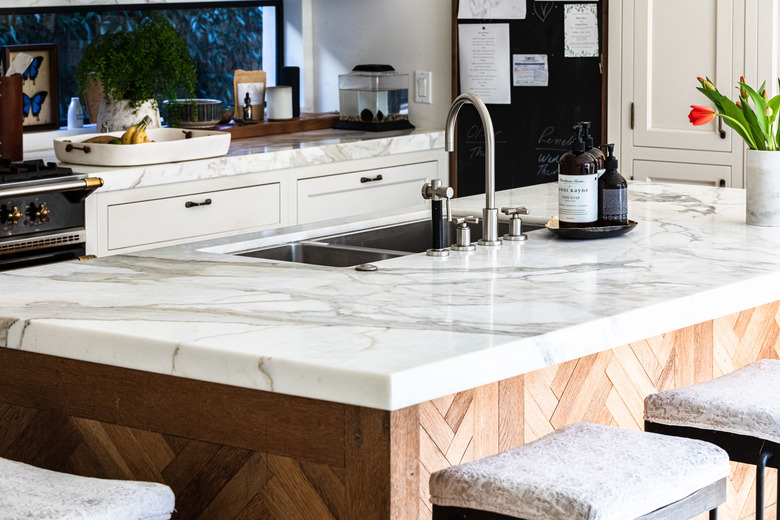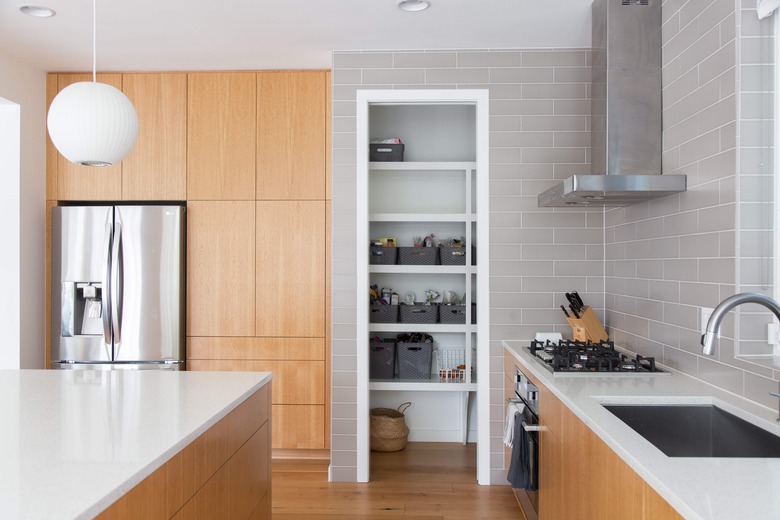Kitchen Sinks: A Homeowner's Guide
We may receive a commission on purchases made from links.
Some houses lack amenities that others have, such as air conditioning, a dishwasher and perhaps even a bathtub, but every house has a kitchen sink. It's as much of a necessity as a working bathroom, and without one, a home isn't a home. So it's no surprise, given the diversity of lifestyles and decor preferences in the contemporary world, that there's more than one kind. In fact, there are five, but if you count the wide variety of sink materials and sizes available, the choices are almost unlimited.
No sink would be complete without a faucet, of which there is also a wide range of options. Together, the kitchen sink and faucet are the centerpiece of the kitchen, and some homeowners go so far as to design the kitchen around these essential elements. If you're like most, however, you'll choose them to match your existing décor, so it's good to have an overview of what's available in terms of appearance, utility and ease of installation.
The Five Types of Kitchen Sinks
The Five Types of Kitchen Sinks
In the days before sanitary plumbing, which weren't that long ago, a kitchen sink was basically a basin that you placed on the kitchen counter, filled with water and emptied manually when you were done with it. In the late 1800s, when P-traps and venting made permanent plumbing possible, sinks could be mounted to the cabinets and connected directly to the waste system. Since that time, every kitchen sink has the following features:
- A drain opening in the bottom that connects to the P-trap
- A shape that slopes downward toward the drain strainer
- Overflow holes that connect to the waste system and prevent the sink from overfilling
Apart from these features, kitchen sinks vary considerably in design and materials and can be oval, rectangular or even triangular, but they all are one of five basic types:
Drop-In
Also known as self-rimming or top-mount, drop-in sinks have a rim that rests on the countertop. They are among the easiest sinks to install because you just have to drop them into a precut hole, which is one reason the drop-in is the most common type of sink.
Undermount
The undermount kitchen sink became popular when designers in the mid 20th century sought the Euro look by installing stone or solid-surface countertops and mounting the sinks underneath to achieve a cleaner, rimless appearance. Undermount sinks are almost as popular as top mounts, but they are more difficult to install because they must be supported by posts screwed or glued to the underside of the countertop, and they don't work with all countertop materials, particularly laminates.
Farmhouse
Also known as an apron sink, a farmhouse kitchen sink is usually large and features a front panel — or apron — that extends beyond the cabinet facing. The farmhouse kitchen sink evokes the days before plumbing when sinks were basically large basins, but contemporary farmhouse sinks are as stylish as they are utilitarian. Installing a farmhouse sink usually requires extensive modifications to the cabinet.
Integrated
An integrated sink is molded into the countertop, which can be made of solid-surface material or stainless steel. A stainless-steel integrated sink, which is the one most appropriate for a kitchen, is known as a drainboard sink. No installation is required other than affixing the countertop to the cabinet and hooking up the plumbing.
Wall Mount
Most appropriate in situations that require a utility sink, a wall-mount sink attaches directly to the wall. It can be a useful addition to a busy kitchen that needs an extra washing station but has no room for more cabinets. It gets screwed to the wall studs, and the plumbing underneath is usually visible.
How Many Basins are Necessary?
How Many Basins are Necessary?
Before dishwashers became ubiquitous, the double-bowl sink with a divider that separates the sink into two washing areas made a lot of sense. You could fill one bowl with soapy water and the other with rinse water, making the task of washing dishes that much easier and more efficient. Many people with dishwashers still prefer double-bowl sinks over single-bowl ones, but double sinks aren't without their drawbacks:
But a double-bowl sink is a definite plus if you have a garbage disposal because you can stack dishes in one bowl and leave the garbage disposal accessible. To save space, some double-bowl sinks come with bowls of different sizes so you can mount the garbage disposal to the smaller bowl and leave the larger one for dishes.
Kitchen Sink Materials
Kitchen Sink Materials
Stainless Steel
About 70 percent of the world's kitchens feature a stainless steel sink, says Swiss sink manufacturer Franke, likely because stainless steel is lightweight, inexpensive and hygienic. The three major kitchen formats, including drop-in, undermount and farmhouse, are available in stainless steel, and drainboard sinks are almost always made of this material.
Enamel (Cast Iron and Fireclay)
Cast iron and fireclay come coated with a baked-on enamel finish, which is usually white. Both of these materials are heavy and add an element of solidity to the kitchen design. They are easy to clean and scratch-resistant, and unlike a copper or stainless-steel kitchen sink, the hard enamel finish won't sustain stains from bleach and household acids, such as vinegar and citrus juice.
Composite
Composite sinks are manufactured with a combination of 80 percent crushed granite or marble and 20 percent resin and have the appearance of stone without the maintenance problems. Composite sinks are nonporous and easy to clean, and they have an attractive dark color that highlights light countertops and kitchen walls.
How to Choose a Sink
How to Choose a Sink
Appearance is a major factor when choosing a sink, but before you get to that, you have some practical considerations:
- How much countertop space do you have? Don't forget to leave enough room for food prep and storage on both sides of the sink and to allow room in the back for the faucet.
- How deep should the sink be? Bowl depth varies from 7 to 10 inches. Although a deeper sink allows you to stack more dishes, it requires more reaching, which can be hard on your back and difficult for children.
- Do you have a precut hole? If so, you can modify it to accommodate a larger sink, but you can't use a sink smaller than the hole.
- What is the countertop material? If it's laminate, your choices are limited to top-mount and farmhouse sinks. You can't install an undermount sink.
- How much work are you willing to do (or pay for)? A top-mount sink is fairly easy to install in an existing countertop, and if you want to replace the countertop, a drainboard sink is even easier. An undermount is more challenging, but a DIY installer can handle it by following the manufacturer's instructions. Farmhouse sinks, or apron-front sinks, require modifications to the sink cabinet that are best handled by a pro.
Options for Kitchen Faucets
Options for Kitchen Faucets
Depending on the type, a kitchen faucet may require one, three or four predrilled holes in the rear deck of the sink, and your sink choice may constrain your choice of faucets. The exception is if you choose an undermount sink or a farmhouse sink that mounts under the countertop because then you can drill the faucet holes yourself in the countertop. You also don't need predrilled holes if you choose a wall-mount faucet.
If your sink deck has a single faucet hole, you'll be limited to faucets that fit through that hole, but that still gives you plenty of options:
- Pull-down faucets have a goose neck and a spray head that pulls down toward the sink.
- Pull-out faucets have the same type of spray head, but you can pull it directly toward yourself instead of down toward the sink.
- Single-handle stationary faucets don't pull out or pull down, but they may swivel. They tend to be the most stylish faucets, and they may be touch-activated or have motion sensors that turn on the water automatically, which can be a real convenience when you have your hands full.
Your sink may come with three predrilled faucet holes, but that doesn't mean you can't use a single-hole faucet because many of them come with cover plates that hide the unused holes. However, your options also include double-handle faucets, which can be mounted on a deck plate that covers the middle hole or may be widespread, meaning the faucet handles are connected to the spout with under-counter hoses to give the impression that the handles are separate from the spout.
Should you choose a four-hole sink, you'll be able to install a three-hole faucet that has a detached sprayer or a single-hole faucet with multiple accessories, such as a sprayer, a soap dispenser and, if your local code requires one, an air gap for the dishwasher.
A wall-mount faucet or a pot filler, which also mounts in the wall, is a great option when you install an undermount or farmhouse sink in a stone countertop. Stone is a difficult material through which to drill faucet holes, and if you don't want to do this yourself or hire a pro to do it, a wall-mount faucet allows you to bypass the need to do it at all. A pot filler has an extended spout that will reach a pot sitting on the stove or countertop, which is a big advantage in a busy kitchen.

